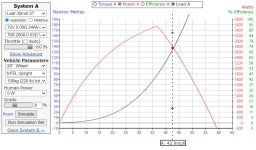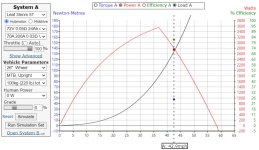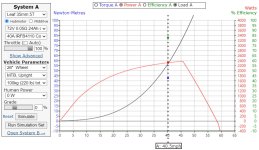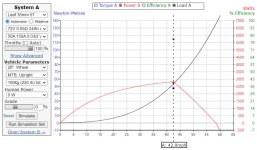You are using an out of date browser. It may not display this or other websites correctly.
You should upgrade or use an alternative browser.
You should upgrade or use an alternative browser.
how to know if you're current or voltage limited for top speed ?
- Thread starter rexey64
- Start date
Most likely (except current/power limit is set very low), your top speed is limited by voltage.
Are you using a display which shows drawn battery amperes or watts? If the motor draws less amps or watts at top speed than at it's peak (which is the case in most cases), then your top speed is limited by voltage.
If your controller supports field weakening, you can also increase top speed by increasing field weakening current.
Are you using a display which shows drawn battery amperes or watts? If the motor draws less amps or watts at top speed than at it's peak (which is the case in most cases), then your top speed is limited by voltage.
If your controller supports field weakening, you can also increase top speed by increasing field weakening current.
Since this is a common question, I'm going to use pictures to explain how I look at it.rexey64 said:let's say you want a higher top speed but you don't know if you can just get it with more current, or if you need a higher voltage.
if you don't have the motor specs like KV, can you measure them and find out what you need ?
It depends on what your top speed is now, how your bike is setup, and your riding position. Fortunately there are a couple of tools that help explain the relationships and estimate the impacts.
For this example, I'm using this as the base case. My assumptions are flat ground, and the motor and battery stay fixed in all examples. I'm also only showing load and power in the graph since that's what I'm focusing on. Note that where load and power lines intersect is the top speed, and in the base case, that point is NOT the peak power that the controller can provide:

The load, on flat ground, it comprised of wind and rolling resistance. In these examples, I'm keep rolling resistance fixed, so the graph below simulates slightly lower than the no load speed of the system, and slightly higher load (to display the actual no load speed, the rolling resistance should be reduced for wheel off the ground, since that would lower the necessary power more to around 40 watts, instead of the 120-ish watts shown in the graph):

If the wind resistance were higher than the base case, you can see that the load graph increases and at some point is equal to the peak power the system can provide:

It's really the wind resistance in these cases that is important.
Now, getting back to the base case and the impact of changing the controller/current limits. In the base case, increasing the controller current limit will make no difference in top speed, since the controller can provide a lot more power than is necessary to attain the existing top speed. The motor winding and voltage are the limiting factors.

In this example, where current is limited to about half of the base case (40A), you can see that power is the limiting factor to move further up on the load curve, and there is a opportunity to increase speed by increasing power:

There is a point where the power, load, and top speed max out, and beyond that point, more power won't increase the top speed. Note that in this example, the top speed of 50A controller is the same as the 70A controller (42.3mph):

Bottom line is that wind resistance is the biggest factor of whether adding more power would increase speed, which is why with the same power, a recumbent can go twice as fast as an upright riding position. Tire pressure and type (eg. fat vs high pressure road) also contribute, but not exponentially.
These two tools are great for getting a feel for these relationships:
http://kreuzotter.de/english/espeed.htm
https://ebikes.ca/tools/simulator.html
You can model your existing setup by using your existing controller current, battery voltage, and modifying the motor Kv in the custom settings to result in your existing top speed, and see where you are along the power curve, relative to the power curves to see it there is an opportunity to increase speed by increasing the current limit.
I'm sure this will be a dumb question, but I'm trying to soak in as much of this battery and electrical component knowledge as possible. Not new to bicycling, but I'm a greenhorn on most of the ebike issues. Question is, how did the responders know what motor the OP is refering to here? Is it that most of these ebike motors have the same controller design, and the discussion can be very general? I thought there were some radically different controllers with different ways to produce power. Just curious.
TNC said:I'm sure this will be a dumb question, but I'm trying to soak in as much of this battery and electrical component knowledge as possible. Not new to bicycling, but I'm a greenhorn on most of the ebike issues. Question is, how did the responders know what motor the OP is refering to here? Is it that most of these ebike motors have the same controller design, and the discussion can be very general? I thought there were some radically different controllers with different ways to produce power. Just curious.
The OP's question is hypothetical (since the is no actual info provided). If he supplied specifics, he could get a more specific answer; so the response has to be based on the stated assumptions, in order to describe the general relationships between power, load, and speed. The tools can be used for a specific case. I should have mentioned that the examples also assume no field weakening. Square wave, Trapazoidal, Sine Wave, or FOC commutation may affect efficiency, but I turned off those graph lines, since the OPs question is limited to current/power and speed.
PS, I always choose the Leaf 5T since it's likely my next upgrade, so I tinker with various scenarios to see what I'll get under my riding conditions. The 70A, 200A phase is attempting to model my current controller. I messed up the last graph since I forgot to lower the phase amps for the 50A controller but it's corrected now. The 40A controller is just selected from the drop down.
ZeroEm
1 MW
by E-HP » Aug 10 2021 4:45pm
TNC wrote: ↑Aug 10 2021 2:59pm
I'm sure this will be a dumb question, but I'm trying to soak in as much of this battery and electrical component knowledge as possible. Not new to bicycling, but I'm a greenhorn on most of the ebike issues. Question is, how did the responders know what motor the OP is refering to here? Is it that most of these ebike motors have the same controller design, and the discussion can be very general? I thought there were some radically different controllers with different ways to produce power. Just curious.
The OP's question is hypothetical (since the is no actual info provided). If he supplied specifics, he could get a more specific answer; so the response has to be based on the stated assumptions, in order to describe the general relationships between power, load, and speed. The tools can be used for a specific case. I should have mentioned that the examples also assume no field weakening. Square wave, Trapazoidal, Sine Wave, or FOC commutation may affect efficiency, but I turned off those graph lines, since the OPs question is limited to current/power and speed.
PS, I always choose the Leaf 5T since it's likely my next upgrade, so I tinker with various scenarios to see what I'll get under my riding conditions. The 70A, 200A phase is attempting to model my current controller. I messed up the last graph since I forgot to lower the phase amps for the 50A controller but it's corrected now. The 40A controller is just selected from the drop down.
How many Volts?
I don’t know why to make it so complicated.
If one can still draw max. amps or watts at top speed, it’s the current that’s limiting.
If amps and watts at top speed are lower than peak it’s the voltage that is limiting.
For example:
20mph full throttle it draws 2000W, 35mph top speed it draws 1200W: voltage is limiting.
20mph full throttle it draws 1000W, 32mph top speed it draws 1000W: current is limiting.
If one can still draw max. amps or watts at top speed, it’s the current that’s limiting.
If amps and watts at top speed are lower than peak it’s the voltage that is limiting.
For example:
20mph full throttle it draws 2000W, 35mph top speed it draws 1200W: voltage is limiting.
20mph full throttle it draws 1000W, 32mph top speed it draws 1000W: current is limiting.
ZeroEm
1 MW
Some people like visual aids.
wow, thank you for all that information !
to get les theorical, i'm actually driving an electric scooter ( the kind where you're standing up) so the wind resistance must be quite high at high speed.
it's a two motors setup, 72v, and the peak current of each controller is probably around 70 amps ( 50 amp stock, but i shunt moded them )
i don't know much about the motors except that they're 6.5inch hub motors rated for 4000w peak, and the no load speed is above 100kph ( displays stops at 99kph )
the max speed i've reached was around 80kph, but it was around 40% battery so idk what the max speed would be at full voltage.
to get les theorical, i'm actually driving an electric scooter ( the kind where you're standing up) so the wind resistance must be quite high at high speed.
it's a two motors setup, 72v, and the peak current of each controller is probably around 70 amps ( 50 amp stock, but i shunt moded them )
i don't know much about the motors except that they're 6.5inch hub motors rated for 4000w peak, and the no load speed is above 100kph ( displays stops at 99kph )
the max speed i've reached was around 80kph, but it was around 40% battery so idk what the max speed would be at full voltage.
With my bicycle, I get around 80% of my no load speed (42km/h -> 55km/h).rexey64 said:wow, thank you for all that information !
to get les theorical, i'm actually driving an electric scooter ( the kind where you're standing up) so the wind resistance must be quite high at high speed.
it's a two motors setup, 72v, and the peak current of each controller is probably around 70 amps ( 50 amp stock, but i shunt moded them )
i don't know much about the motors except that they're 6.5inch hub motors rated for 4000w peak, and the no load speed is above 100kph ( displays stops at 99kph )
the max speed i've reached was around 80kph, but it was around 40% battery so idk what the max speed would be at full voltage.
So you might be limited by your voltage. But on the other hand, at 80km/h, air resistance is so big that I doubt 4000W would be enough to go faster.
One last thing, those scooter are really not the best for stability and manoeuverability, going at those speeds will easilly get you injured real good, but I guess you already know that.
yeah i already know that 
also mine is quite big for an electric scooter, ( around 1.4 wheel base ) with good shock absorbers, a steering damper, and wide 13 inch tyres. i also ride with motorcycle gear.
honestly beside the really twitchy throttle it's a really smooth and stable ride.
also, i'm 99% of the time on 30/50 kmh roads anyways, so i rarely go above 55.
also mine is quite big for an electric scooter, ( around 1.4 wheel base ) with good shock absorbers, a steering damper, and wide 13 inch tyres. i also ride with motorcycle gear.
honestly beside the really twitchy throttle it's a really smooth and stable ride.
also, i'm 99% of the time on 30/50 kmh roads anyways, so i rarely go above 55.
See if you can measure the top speed with the wheel lifted off the ground. Then compare that with the top speed you get actually riding. If the actual riding speed is around 80% of the no-load speed, then you are probably voltage limited.
fechter said:See if you can measure the top speed with the wheel lifted off the ground. Then compare that with the top speed you get actually riding. If the actual riding speed is around 80% of the no-load speed, then you are probably voltage limited.
You can probably feel it too, if acceleration drops off quickly before the top speed, since the torque curve takes a dive at the same speed the power curve does.
Similar threads
- Replies
- 12
- Views
- 198
- Replies
- 0
- Views
- 209
- Replies
- 2
- Views
- 395

